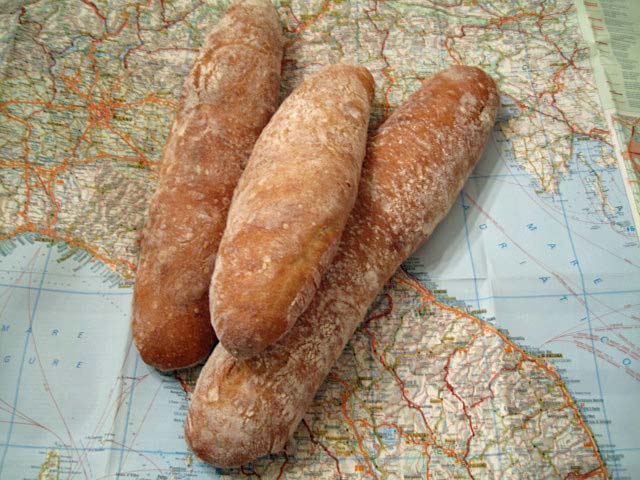
Tre Franceses
“Pan Francese” simply means “French Bread” in Italian. It is a long, thin loaf that is the Italian version of a baguette. Daniel Leader has a formula in Local Breads which he titles “Italian Baguettes” and says are called “Stirato,” which means “stretched” in Italian. Michel Suas' Advanced Bread and Pastry includes a formula for “Pan Francese,” and we made this bread during the Artisan II workshop at SFBI.
The differences between Leader's and Suas' formulas are relatively minor. Leader uses a biga at 60% hydration, and the biga is 61% baker's percentage of the total dough. Leader's dough hydration is 70%. Suas' hydration is 76% - a significant difference. Suas uses a poolish (100% hydration), and the poolish is 50% baker's percentage of the total dough. Leader uses all AP flour, while Suas' formula uses 13.6% whole wheat flour, the rest being AP. Leader's mixing instructions, as usual for his high-hydration doughs, call for an intensive mix (10-12 minutes at Speed 4). Suas specifies a short mix but 2 or 3 folds during bulk fermentation. Their shaping instructions are also significantly different: In spite of pointing out that “Stirato” means “stretched,” Leader tells you to shape the loaves like you do baguettes. Suas has you simply cut long strips of dough and stretch them to shape.
Of course, there is no end to variations with breads. The Il Fornaio Baking Book, from the bakery chain of the same name, has a recipe for “Sfilatino” which they call “Italian Baguettes.” Theirs are made with a biga. They are shaped as demi-baguettes, then stretched to about 15 inches long.
The “Pan Francese” I made followed Suas' formula and method from AB&P.
|
Poolish |
Baker's % |
Wt. (oz) |
|
AP flour |
100 |
3 5/8 |
|
Water |
100 |
3 5/8 |
|
Yeast (instant) |
0.1 |
1/8 tsp |
|
Total |
200.1 |
7 1/8 |
-
Mix all the ingredients until well-incorporated.
-
Ferment for 12-16 hours at 65ºF.
|
Final dough |
Baker's % |
Wt. (oz) |
|
AP flour |
79.52 |
11 7/8 |
|
WW flour |
13.48 |
2 3/8 |
|
Water |
70 |
10 |
|
Yeast (instant) |
0.35 |
¼ tsp |
|
Salt |
2 |
¼ oz |
|
Malt |
0.98 |
1/8 oz |
|
Poolish |
50.03 |
7 1/8 |
|
Total |
223.36 |
2 lb |
|
Total dough |
Baker's % |
Wt. (oz) |
|
AP flour |
86.4 |
15 1/2 |
|
WW flour |
13.6 |
2 3/8 |
|
Water |
76 |
13 5/8 |
|
Yeast (instant) |
0.3 |
1/2 tsp |
|
Salt |
1.6 |
¼ oz |
|
Malt |
0.78 |
1/8 oz |
|
Total |
178.68 |
2 lb |
Method
-
Prepare the poolish the evening before mixing the dough.
-
Measure all the Final dough ingredients into the bowl. (I used a KitchenAid mixer.)
-
Mix with the paddle until ingredients are well mixed – 1-2 minutes -then switch to the hook and mix at speed 2 or 3 for about 5 minutes. There will be some gluten development, but the dough will not clear the sides of the bowl. It will be like a thickish, glutenous batter.
-
Transfer the dough to an oiled bowl and cover tightly.
-
Ferment for 3 hours with 2-3 stretch and folds on a well-floured board.
-
Prepare your oven with a baking stone and your steaming apparatus of choice in place. Pre-heat the oven to 500ºF about 30 minutes before the end of fermentation.
-
Transfer the dough to a well-floured board. De-gas the dough and stretch and pat it into a rectangle about 8 x 12 inches. Dust the top with flour.
-
Using a bench knife, divide the dough into 3 strips. Stretch them to about 15” long and place them on a well-floured linen couch. (I suppose parchment paper would serve.). Cover with linen or a towel.
-
Proof for 30-45 minutes.
-
Transfer the loaves to a peel and then to the baking stone. Turn the oven down to 460ºF and steam it.
-
Bake for 22-25 minutes.
-
Transfer the loaves to a cooling rack. Cool for at least 30 minutes before slicing.
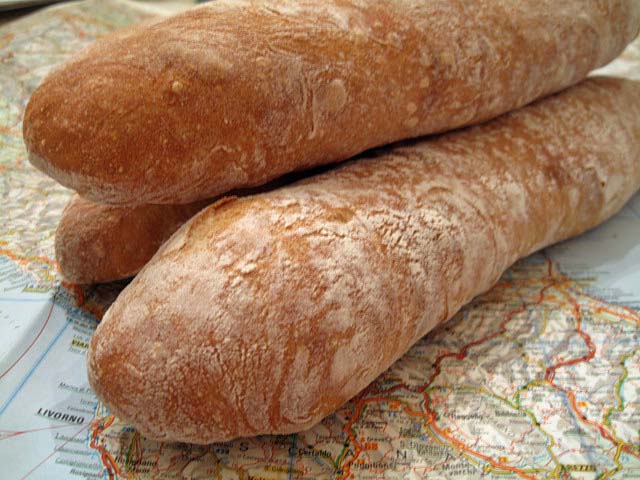
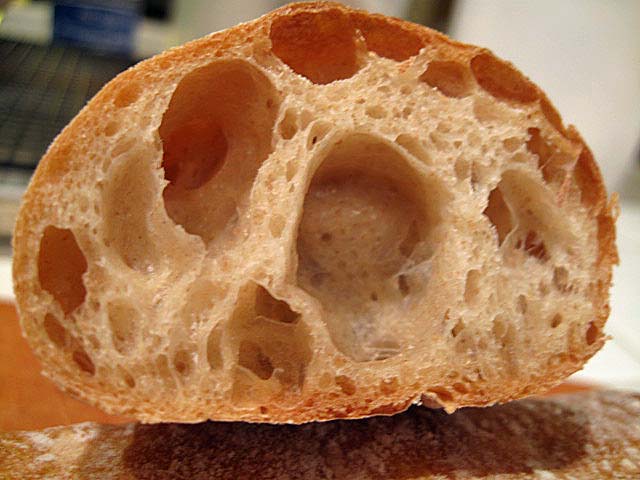
Francese cross section crumb
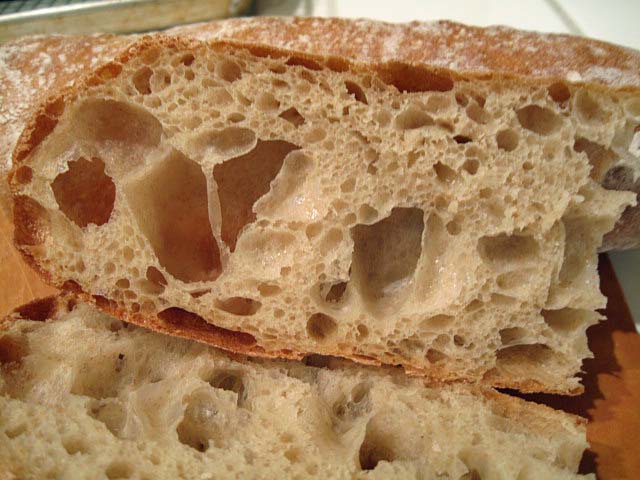
Francese longitudinal section crumb
The loaves had a thin, crisp crust that got chewy as it cooled. The crumb was very open with some chewiness. The flavor of the whole wheat was present when tasted still slightly warm. I expect it to meld by tomorrow. The flavor was similar to ciabatta, not surprisingly. The bread was nice as a chicken salad sandwich for dinner.
David
Submitted to YeastSpotting
- dmsnyder's Blog
- Log in or register to post comments
The poolish constituted 50% of the final dough. That is a significant amount. How does it compare to a dough where the poolish makes up 30% of final dough? I have never gone higher than the standard 30%. Would you say there is a big difference? Lovely looking exterior and crumb, David. For me that is the perfect amount of flour on the crust. Just enough to give it a rustic look, but not so much that the entire crust is covered with it. Really attractive. :)
Syd
Using a higher percent pre-ferment results in greater gluten development with less mixing. In general, a short mix requires a longer fermentation. This dough ferments for only 3 hours. The higher percent of pre-fermented dough allows the shorter fermentation.
I'm just speculating on Suas' rationale. Others may have ideas about this.
David
Very interesting comparison between Leader and Suas here. It does seem Suas is attempting to be more authentic in this case. The crumb certainly didn't suffer from lack of slashing did it? Very nice. I love the even crust. Would you suggest drying out with the door open to hold the crisp longer?
Eric
Actually, I left the loaves on the stone with the oven off, door ajar for 7 minutes. But this is a pretty wet bread, and the crust was quite thin. I think what I got was probably typical for this bread. It's basically a ciabatta with a different shape.
The dough was extremely extensible. This, and the use of steam, allowed great oven spring without bursting, so slashing was not needed.
David
Pretty Airy Loaf.
I remember these from your SFBI output. They're so light, they'd be good floatation devices. The perfect bread for boaters.
Glenn
This bread is much better dipped in olive oil than in lake water.
David
The crumb and crust look beautiful and no slashing required. I think Italian housewives and bakers must enjoy making these often. I've always liked the idea making the shorter baguettes. I bet one would fit in my tackle box...I've put them on my 'to do' list. Nicely done, David!
Sylvia
I have no idea what Italian housewives bake. My impression is that Francese are mostly a bakery bread and were bakeries' response to customer demand for "French bread."
This is a very easy bread to make, if you are already comfortable with very slack dough.
Please let us know how yours turn out.
David
Hello David, Your Pane Francese loaves are very nice, and in addition to the crumb shot, I love the "map shot"!
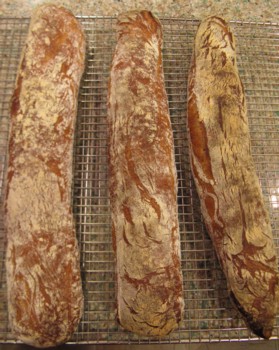
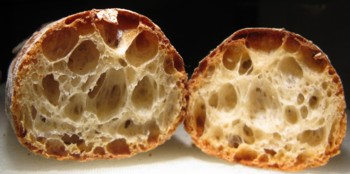
I was going to bake something else yesterday but changed my mind and made Pane Francese, after seeing the results you got (lovely!) and reading through the method (requiring minimal handling of the dough).
Re: minimal handling, not having gotten the hang of "iron hand in a velvet glove" yet, I thought perhaps the less I touch the dough the better odds of the bread having an open crumb!
After the bake, the loaves felt light for their size; this was encouraging.
Here are a couple of pictures:
Thanks, David, for your inspriration for this effort, and for directing me to yet another of Mr. Suas' wonderful formulas!
from breadsong
You sure got your open crumb! The loaves look wonderful.
What did you think of the flavor?
David
David, thanks for your compliments!
We *love* the flavor along with that crisp, crisp crust.
I'm looking forward to making this bread again!!!
from breadsong
to Pain a l'Ancienne?
Since I'm used to handling slack dough and cutting it in slices, I'm quite interested in making this bread. I also like the idea of the addition of some whole wheat - I often put some whole grain in my Pain a l'Ancienne.
Thanks for sharing your formula "hybrid",
Karin
Hi, Karin.
Hmmm..... It's been a while since I made pain à l'anciènne. (I make the version that Gosselin gave to PR.) I remember it as having a sweet and complex flavor from the long cold retardation.
The pain francese has a nice flavor that had a noticeable WW flavor tone when first cooled. I froze most of the batch, but I thawed some last week for breakfast. I would say that the flavor was "nice, average baguette sur poolish."
Now, I've just made this once at home, so I hesitate to generalize. Okay. Hesitation is completed. I'd say that the pain francese is a good bread to have in your repertoire. Its eating quality is very acceptable. Its chief virtues are how easy it is to make and its nice, rustic appearance.
If your goal is the very best tasting baguette, this isn't it IMHO.
David
Hello David,
Yesterday I made Pan Francese and we love it. It has everything what we like in a baguette. The crust was really thick and crispy. But, when I look at your crumb and the holes in it, I can't find them in my delicious Pan Francese. How do I get those holes in my crumb?
I did almost everything you wrote, except the shaping. I was so happy being able to shape it, because it was so very sticky. I'm still learning and trying to shape a good looking baguette. This time I'm very pleased, it does look like a real baguette.
Hope you can help for the next Pan Francese
Connie http://mydiscoveryofbread.blogspot.com
Hi, Connie.
If you shaped the loaves as you would French baguettes, you probably de-gassd the dough too much. These loaves are meant to be simply cut off the mass of dough and stretched to shape ... gently.
David
David,
Thank you so much. This week I will make them again, and this time no shaping but stretching. Hope to show you open crumb.
Connie
Hi David,
I baked the great Pane Francese you posted above today after I saw Franko and breadsong's, and yours of course.
While I was shaping the dough, the length of the dough were getting longer and longer.. One of them is too long to put it in the oven so that the one side is crooked like this:
We ate the other one as soon as I took it out of the oven, so there is no pictures of it.... but I have the crumb shot..
Wow, The crust is very thin and crispy... Very crispy! We all loved the flavor of the whole wheat in it. My daughter really enjoyed it too.
I am going to make it again, too.
Thank you for sharing this great bread, David!
Akiko